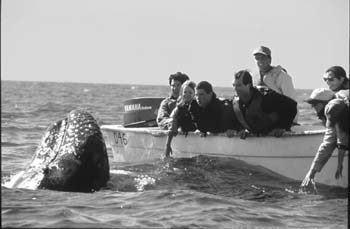The Whale Channel
Viewing big-time sea life can be easy on the Central Coast
By Eric Johnson
THE MONTEREY BAY AREA is one of the best places in the world to watch whales, and now is the time to do it. The gray whales' northern migration can be viewed from many clifftops north of Santa Cruz--especially around Año Nuevo Island. The whales are two weeks out of Baja and two months from Alaska, headed from the bays where they mate and give birth to the feeding grounds where they will live until winter. During most of the 12,000-mile trip--the longest animal migration in the world--they will stay close to shore. Nobody really knows why.
Though a pretty good pair of binoculars enriches the whale-watching experience, all that's required to get a hit of their weird power is patience. This coming weekend, one or two "pods," each made up of two or three whales, will pass by every hour or so.
Look for the 'V' shaped spouts, maybe 200 yards out. Whales surface to breathe and maybe catch some rays--they are mammals, after all.
Although they may be cruising at a respectable seven knots, the whales appear to be moving in enormous slow motion. Theirs is a near-monstrous grace. Occasionally, one will breach, performing an impossible, dolphin-like air-dive. Last weekend at Greyhound Rock, five miles north of Davenport, some friends and I watched a gray execute an Olympian head-breach, thrusting 10 feet of its upper body toward the sky.
After an hour or so of clifftop whale-watching, the motion of the water can become hypnotic. Wind-chop begins to resemble spout-spray. Certain waves take on the appearance of huge white-barnacled dorsal ridges. But soon a shadowy form will appear below the surface, the water will part, and when the incredibly big thing appears, it can be almost frightening.
As the gray whale migration slows, and females with babies as well as older males straggle through the Bay, killer whales will appear (not coincidentally). Around May, whales which feed on plankton and bait fish in the bay will arrive, including great blues--the biggest whales--and humpbacks, known for their spectacular displays.
Dolphins, the whales' cousins, can also be found throughout the Monterey Bay area, sometimes running in huge pods--from 200 to 2,000 individuals. A small pod could be seen playing off the cement boat at Rio Del Mar last Sunday. Other sea mammals, like sea lions, harbor seals and once-rare sea otters, are everywhere.
Many charter boats offer an opportunity to get up-close and personal with whales and other sea mammals.
On Monterey's Fishermen's Wharf, Sam's Fishing Trips offers whale-watching tours year-round with Captain Richard Turnullo and marine biologist Donna Black. (408/327-0577)
Monterey Sport Fishing (408/372-2203), Chris's Fishing Trips (408/375-5951) and Randy's Fishing Trips (408/372-7440) will also offer gray whale tours for the next couple of weeks.
Chardonnay Sailing Charters, out of Santa Cruz Harbor, offers an opportunity to watch whales from a sailboat. Its last gray whale-watching tour, with naturalist Julie Near, takes place this Saturday, April 4, from 10am until 1pm. The boat will go out to look at humpbacks in July and August. (408/423-1213)
Also from the Santa Cruz Yacht Harbor, Stagnaro Fishing Trips will continue to offer gray whale-watching tours daily for the next couple of weeks, at 11am on weekdays and 3pm on weekends. (408-427-2334)
For an even closer encounter, the Kayak Connection out of Santa Cruz offers a chance to get in the water with the grays, at 8am every Sunday through April. (408/724-5692)
[ San Jose | Metroactive Central | Archives ]
Copyright © Metro Publishing Inc. Maintained by Boulevards New Media.
![]()

Richard Sobol--IFAW
From the April 2-8, 1998 issue of Metro.
![[Metroactive Features]](/features/gifs/feat468.gif)